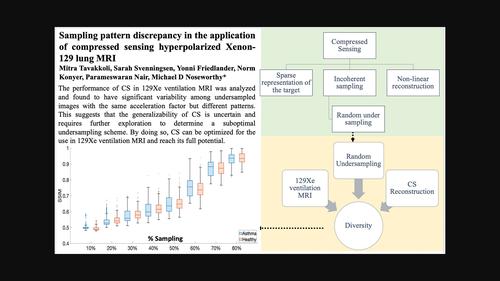当前位置:
X-MOL 学术
›
NMR Biomed.
›
论文详情
Our official English website, www.x-mol.net, welcomes your feedback! (Note: you will need to create a separate account there.)
Sampling pattern discrepancy in the application of compressed sensing hyperpolarized xenon‐129 lung MRI
NMR in Biomedicine ( IF 2.9 ) Pub Date : 2024-03-01 , DOI: 10.1002/nbm.5121 Mitra Tavakkoli 1, 2 , Sarah Svenningsen 3, 4, 5 , Yonni Friedlander 3 , Norman B. Konyer 1 , Parameswaran Nair 3, 4 , Michael D. Noseworthy 1, 2, 5, 6
NMR in Biomedicine ( IF 2.9 ) Pub Date : 2024-03-01 , DOI: 10.1002/nbm.5121 Mitra Tavakkoli 1, 2 , Sarah Svenningsen 3, 4, 5 , Yonni Friedlander 3 , Norman B. Konyer 1 , Parameswaran Nair 3, 4 , Michael D. Noseworthy 1, 2, 5, 6
Affiliation

|
Although hyperpolarized (HP) 129 Xe ventilation MRI can be carried out within a breath hold, it is still challenging for many sick patients. Compressed sensing (CS) is a viable alternative to accelerate this approach. However, undersampled images with identical sampling ratios differ from one another. Twenty subjects (n = 10 healthy and n = 10 patients with asthma) were scanned using a GE MR750 3 T scanner, acquiring fully sampled 2D multi‐slice HP 129 Xe lung ventilation images (10 s breath hold, 128 × 80 (FE × PE—frequency encoding × phase encoding) and 16 slices). Using fully sampled data, 500 variable‐density Cartesian random undersampling patterns were generated, each at eight different sampling ratios from 10% to 80%. The parallel imaging and compressed sensing (PICS) command from BART was employed to reconstruct undersampled data. The signal to noise ratio (SNR), structural similarity index measurement (SSIM) and sidelobe to peak ratio of each were subsequently compared. There was a high degree of variation in both SNR and SSIM results from each of the 500 masks of each sampling rate. As the undersampling increases, there is more variation in the quantifying metrics, for both healthy and asthmatic individuals. Our study shows that random undersampling poses a significant challenge when applied at sampling ratios less than 60%, despite fulfilling CS's incoherency criteria. Such low sampling ratios will result in a large variety of undersampling patterns. Therefore, skipped segments of k ‐space cannot be allowed to happen randomly at low sampling rates. By optimizing the sampling pattern, CS will reach its full potential and be able to be applied to a highly undersampled 129 Xe lung dataset.
中文翻译:

压缩感知超极化氙129肺MRI应用中的采样模式差异
尽管超极化(HP)129 Xe通气MRI可以在屏气内进行,但这对许多病人来说仍然具有挑战性。压缩感知(CS)是加速这种方法的可行替代方案。然而,具有相同采样率的欠采样图像彼此不同。二十个科目(n = 10 健康且n = 10 名哮喘患者)使用 GE MR750 3 T 扫描仪进行扫描,获取完全采样的 2D 多层 HP129 Xe肺通气图像(10秒屏气,128×80(FE×PE——频率编码×相位编码)和16个切片)。使用完全采样的数据,生成了 500 个可变密度笛卡尔随机欠采样模式,每个模式具有从 10% 到 80% 的八种不同采样率。BART 的并行成像和压缩感知 (PICS) 命令用于重建欠采样数据。随后比较了各自的信噪比(SNR)、结构相似性指数测量(SSIM)和旁瓣峰值比。每个采样率的 500 个掩模中的每个掩模的 SNR 和 SSIM 结果都存在很大程度的差异。随着欠采样的增加,对于健康个体和哮喘个体来说,量化指标存在更多变化。我们的研究表明,尽管满足 CS 的不一致性标准,但当采样率低于 60% 时,随机欠采样会带来重大挑战。如此低的采样率将导致多种欠采样模式。因此,跳过了以下部分k ‐空间不能在低采样率下随机发生。通过优化采样模式,CS 将充分发挥其潜力,并能够应用于高度欠采样的情况129 Xe 肺数据集。
更新日期:2024-03-01
中文翻译:

压缩感知超极化氙129肺MRI应用中的采样模式差异
尽管超极化(HP)



























 京公网安备 11010802027423号
京公网安备 11010802027423号